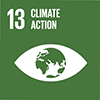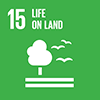Description/achievement of initiative
The course Unité d'Enseignement (niveau master 2): Changements globaux has aimed at presenting some detailed pieces of research on climate change and on the scientific knowledge acquired so far on its origins and consequences of climate. The project Simulation des débâcles de glace de la Lena en Sibérie aims at showing the role of global warming on the dynamics leading to the ice breakup in the Lena River in Siberia. This river is characterized by peak flow of 50,000 m3 / s in a covered area of permafrost. Spring breakup causes floods and a very strong erosion of the banks and islands. The project will be running from 2015 till 2017.The Conférence climat et impacts aims at organizing two scientific conferences focused on the causes and mechanisms responsible for the current and previous climate variability and at assessing the impact that climate change has on our environment and societies. The conferences will be running between 2016 and 2017 for a total of a seven-month period.The University has been involved as well in other projects focused on energy efficiency such as the 'Plateforme prototypale de production d'hydrogène par électrolyse de l'eau', 'Efficient smart systems with enhanced energy storage (E-STARS)' and 'Advanced Materials for high voltage lithium ion battery'.
Implementation methodologies
The research group has been focused on different areas (Ozone and climate change, climate change, land fertilization), adopted different approaches and techniques) and has conducted research on different levels (globe, community, ecosystems, and individuals). The project Simulation des débâcles de glace de la Lena en Sibérie aims to reproduce in the laboratory these ice breakups with an experimental model of an EM3 Little River consisting of a hydraulic channel 2.5 m long. The cold room is used in this case to maintain a frozen ground. Although at a different level, these experiences display the processes occurring in Siberia and especially show the role of climate change on the dynamics of the Arctic regions. The conferences under the programme Conférence climat et impacts will use data on climate variability recorded in the natural archives at different time scales, paying particular attention to: (i) record oscillations of climate (ii) climate system response to external factors, (iii) the role of the ocean and the ocean-atmosphere coupling-cap system, (iv) the mechanisms involved in sudden climate variations. They will also be an opportunity to promote interdisciplinary exchange at scientific and methodological level and build new synergies in the French community to respond to future calls for national and international projects. A training component is also envisaged thanks to Masters Students participation.IRDADans le contexte de l'initiative "l’efficacité et la biodiversité", les sciences naturelles, les sciences économiques et les sciences juridiques doivent agir de concert pour une meilleure « gouvernance de la biodiversité », tel est l’enjeu de cette réflexion sur efficacité et biodiversité. En d’autres termes, c’est mener une réflexion sur les fins, les valeurs, et sur les moyens, les outils, deux questions qui constituent les deux axes de la recherche.1. Premier axe : Valeur(s) et biodiversité2. Deuxième axe : Outil(s) et Biodiversité"Concernant "Preuve et developpement durable", il faut donc repenser les liens du droit et du développement durable sous l'angle des questions probatoires amenant les juristes à travailler avec les représentants des sciences humaines tels que les philosophes et les représentants des sciences dures.Under the Laboratoire Ecologie Systematique et Evolution:InvaCosts has reunited three top teams in the 3 key areas of the project: ecology of invasive species, environmental economics and epidemiology of human health, to build distribution patterns of invasive species, and estimate the economic and societal costs associates. The group has modelled the distribution of 20 species among the most harmful (pest of natural ecosystems, damaging agriculture or forestry, human disease vectors,) to provide predictions of global impacts through climate change. The goal of this investigation/ study carried by the second project of the Laboratory has been to identify the key processes involved in the context of climate change in the functioning and development of European forests to improve the models used for future changes.
Arrangements for Capacity-Building and Technology Transfer
Coordination mechanisms/governance structure
Partner(s)
Université de Paris-Sud





 2016
2016
 2017
2017
 2017
2017
 2018
2018
 ongoing
ongoing
 Time-frame: 2004 - 2017
Time-frame: 2004 - 2017